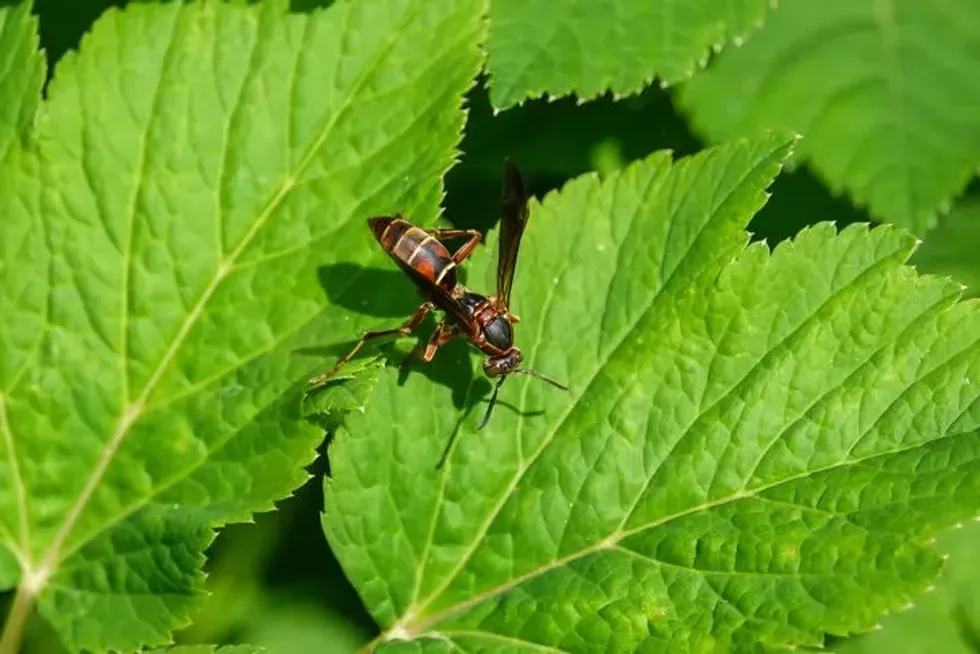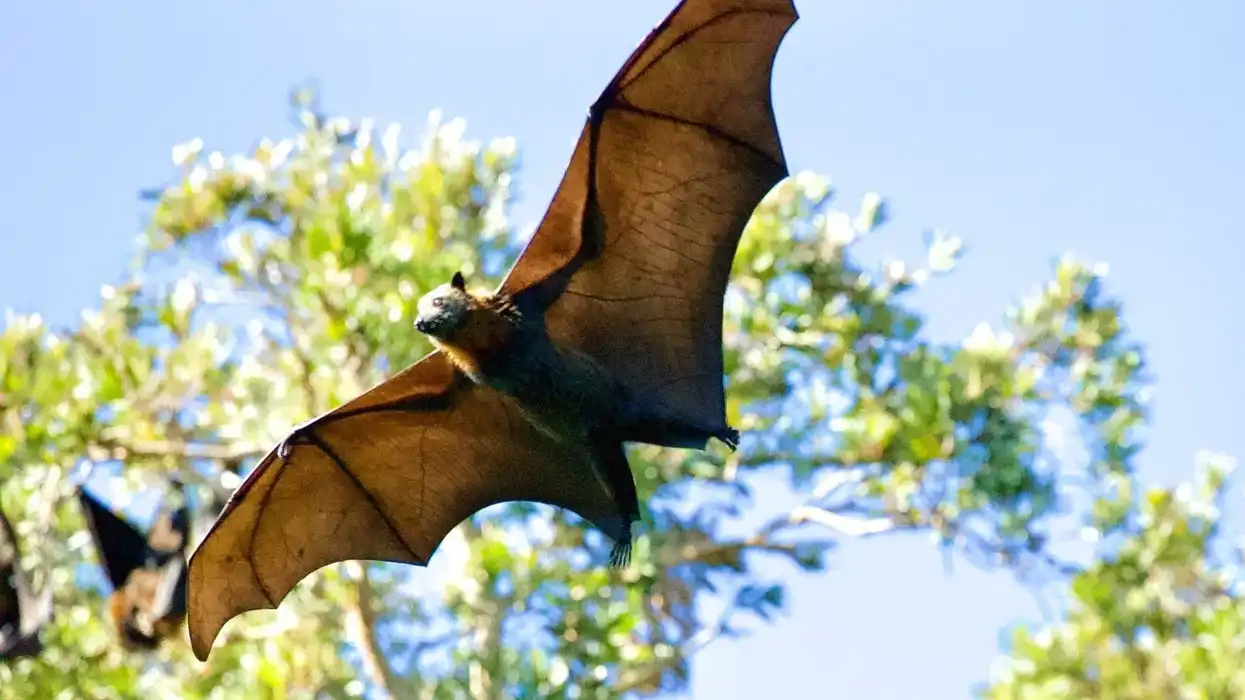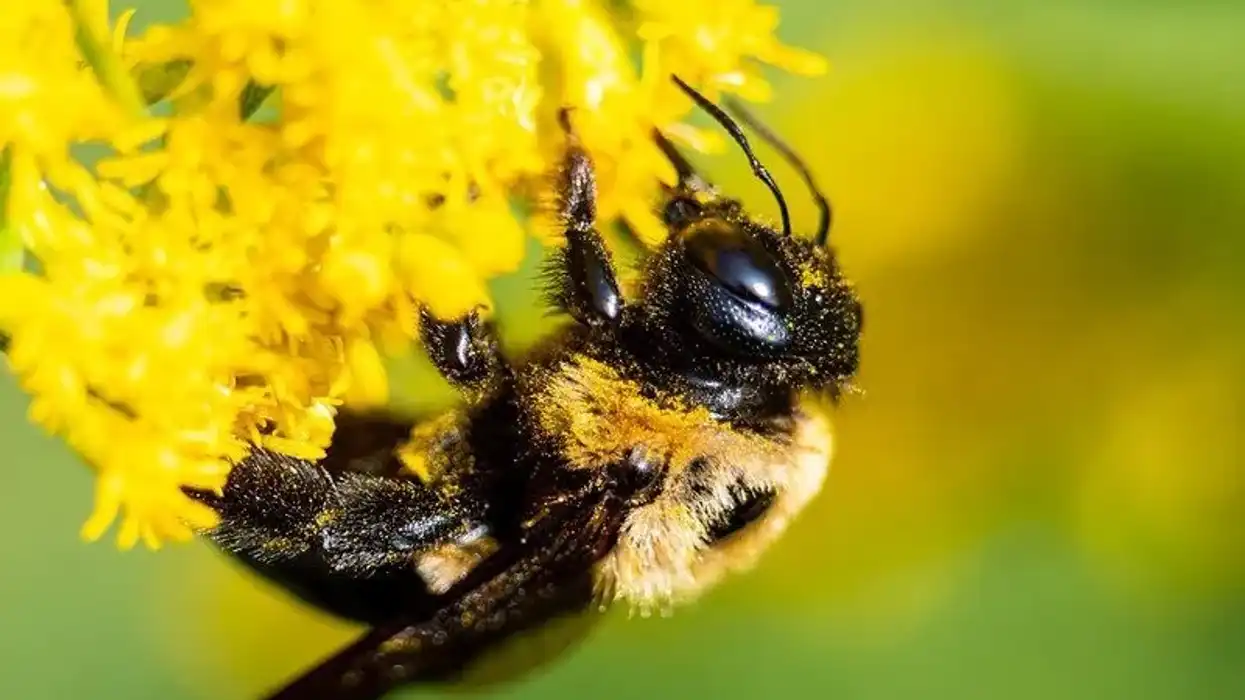The northern paper wasp (Polistes fuscatus) is a common species of wasp found in North America and southern Canada. These wasps are not generally aggressive, but they can be quite dangerous if their nest is disturbed.
They usually live near to is exposed wood, like houses and barns and these northern paper wasps are omnivores, so they feed on garden pests like caterpillars and spiders as well as plant nectar.
If you get too close to their nest or attack it, these paper wasps can sting enough to cause significant pain.
It will feel like a large needle piercing your skin and it may swell and cause allergic reactions. However, despite this pain, their sting is not strong enough to kill humans.
While a small paper wasp nest is not normally a problem, a huge infestation can be dangerous for both humans and other domestic animals. On the flip side, these smart wasps can easily recognize outsiders in their nests, even if they are from the same genus or species!
Dive into some super interesting facts about the northern paper wasp here, and if you enjoyed reading these facts, don't forget to check out some mud dauber wasp and yellow jacket wasp facts too
Northern Paper Wasp Interesting Facts
What type of animal is a northern paper wasp?
The northern paper wasp, or Polistes fuscatus, is a type of wasp that is usually found in areas where exposed wood is abundant like barns, sheds, and forests. The ancestors of these wasps are both bees and ants, and , like their ancestors, these wasps are social and tend to live in nests in a colony.
What class of animal does a northern paper wasp belong to?
The northern paper wasp belongs to the class Insecta and the Polistes genus of the Vespidae family.
How many northern paper wasps are there in the world?
While it is difficult to know the exact number of northern paper wasps in the world, research shows that they are the most common wasp species in North America. This suggests that the population is steady and the risk of extinction is low.
Where does a northern paper wasp live?
Northern paper wasps can be commonly found in woodlands and savannas, especially in temperate North America. You can find them in British Columbia, southern Canada, and Central America. They tend to nest near human habitations, like homes and barns.
What is a northern paper wasp's habitat?
Northern paper wasps tend to look for locations that have sufficient quantities of wood, like woodland areas and forests. This is because wood is an important nest material for them.
Places like houses, barns, and sheds are also common habitat choices. These paper wasps chew wood and use their oral fluids to make a paper-like paste used for binding. In summer, these wasp nests can measure up to a width of 6-8 in (15.2-20.3 cm).
Who do northern paper wasps live with?
Northern paper wasps are social wasps that live together in a nest, often called a colony. One queen dominates the nest and, together with the worker paper wasps, defends the nest from predators and attackers. A single nest of this species can have a total of more than 200 wasps living in it.
How long does a northern paper wasp live?
The average lifespan of a northern paper wasp is about one year. This can vary depending upon the time it takes for the queen to reach sexual maturity and to feed the larvae. The lifespan of worker males and females in the colony is similar and they die with the queen after the eggs start hatching in the fall.
How do they reproduce?
The mating season of northern paper wasps is in summer and spring. Like most wasp families, fertile females and the queen build nests in the fall.
After males and females mate in summer, they hibernate through the winter. In spring, the northern paper wasp queen lays eggs into each cell of the wasp nest. She also hunts small insects or caterpillars as food for the developing larvae.
The eggs hatch in fall and after hibernation, new queens and workers emerge while the old ones die. When these new wasps mature, the reproduction process begins again and the life cycle is repeated.
What is their conservation status?
Northern paper wasps have the conservation status of Least Concern, which means that their population is stable and not endangered.
Since these wasps use caterpillars and insects as food, organic farms welcome their presence as a form of pest control because it reduces the need to use harmful chemical pesticides. Also, since their reproduction process does not take long and the average lifespan of these wasps is one year, their population remains balanced.
They are most commonly found in North America but they still vulnerable to predators like foxes, rodents, and birds here.
Northern Paper Wasp Fun Facts
What do northern paper wasps look like?
Northern paper wasps are reddish-brown or black in color and have distinct yellow markings on their bodies. Their waist is noticeably slim and the average size can be up to0.59-0.83 in (15-21 mm) long.
A northern paper wasp male has a more curved antenna tip and more yellow markings than a female. Females have a venomous sting, which is missing in males.
How cute are they?
Whilst their yellow markings give these northern paper wasps a bee-like look, they are not exactly the cutest wasp species. While the males are safer, female paper wasps can cause an irritable sting which makes them a dangerous pest. Nevertheless, their hardworking and social nature is fun to observe!
How do they communicate?
Like other paper wasps, northern paper wasps secrete chemicals to communicate. The queen wasp also uses threatening body postures to communicate with her subordinates.
These wasps can also differentiate between outsiders and their own species. As soon as an outsider approaches the nests, these paper wasps tend to get aggressive and attack them in order to protect their larvae and nests.
How big is a northern paper wasp?
Northern paper wasps range from 0.59-0.83 in (15-21 mm) in length. This wasp is three times the size of a regular housefly.
How fast can a northern paper wasp fly?
There is no specific research that studies how fast a northern paper wasp can fly, however we do know that an average wasp can fly at the speed of 14 mph (22.5 kmph), and the fastest speed they can reach is 30 mph (48.2 kmph).
How much does a northern paper wasp weigh?
The average weight of a northern paper wasp is not known. An average yellow jacket weighs 0.0014 oz (0.04g) and is a similar size to a small northern paper wasp. Therefore, it can be estimated that an average paper wasp of this species will approximately weigh between 0.0014-0.0017 oz (0.04-0.05g).
What are their male and female names of the species?
There are no designated names for males and females of the northern paper wasp species.
What would you call a baby northern paper wasp?
A young northern paper wasp is named according to the stage it is in: eggs, larvae, or pupae. It can also be called a juvenile until it becomes an adult paper wasp.
What do they eat?
Northern paper wasps mainly feed on plant nectar. They are also omnivores (and sometimes are described as insectivores), so they also eat caterpillars and small insects like ants, flies, termites, and spiders.
These insects are also used as food for larvae. The liquid part of insects is absorbed and regurgitated to feed younger larvae, while the solid part of the insect is given as food to older larvae. The main predators of these paper wasps are humans, the cardinal bird, and the swift fox.
Are they poisonous?
Only females are capable of a venomous sting. They can sting domestic animals like sheep and cows that reside near their nest, for example in a barn.
These wasps are generally only aggressive if their nest is in danger or they feel like they are under attack. If aggravated, they can also attack humans.
The northern paper wasp sting hurts but their stinger can easily be removed from human skin. Despite this, the sting may cause allergic reactions so if in doubt it is always best to seek medical attention.
Would they make a good pet?
Whilst they are not a good pet, they are very valuable to some farmers. Since they hunt insects for food, many organic farms welcome these northern paper wasps as they act as a natural pesticide. This helps farms avoid using chemical pesticides.
Did you know...
Since northern paper wasps have a large number of fertile females that lay eggs in each nest, queen wasp tends to destroy any developing larvae that are not her own to retain authority. She uses a chemical marking to avoid eating her own larvae.
You shouldn't try to kill a wasp head-on, but there are a lot of ways to get rid of a wasp nest safely.
Try to check for nesting sites in spring before the queen has begun building her nest, or look for developing nests with only larvae and no adults. You can also use an anti-wasp spray to get rid of an active nest.
If attacked by a wasp, you should escape the scene and do not kill it, as it will release chemicals to attract more angry adult wasps if you kill it.
Costs and benefits of northern paper wasps
Northern paper wasps feed on garden insects and reduce the need for using pesticides. They also transfer pollen while feeding on plant nectar, thus helping to promote plant reproduction. On the other hand, they can be dangerous to humans, but only if aggravated.
How to tell the females from males
Northern paper wasp males have a distinctly curved antenna and have more yellow markings in comparison to females. However, female paper wasps are the only ones with a venomous sting.
Here at Kidadl, we have carefully created lots of interesting family-friendly animal facts for everyone to discover! Learn more about some other arthropods including the cicada killer wasp, or the paper wasp.
You can even occupy yourself at home by drawing one on our Northern paper wasp coloring pages.










